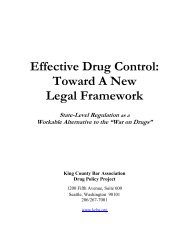RACE AND THE ENFORCEMENT OF DRUG DELIVERY LAWS IN ...
RACE AND THE ENFORCEMENT OF DRUG DELIVERY LAWS IN ...
RACE AND THE ENFORCEMENT OF DRUG DELIVERY LAWS IN ...
Create successful ePaper yourself
Turn your PDF publications into a flip-book with our unique Google optimized e-Paper software.
In sum, the evidence shows that racial disproportionality in downtown, Capitol<br />
Hill, and University District drug delivery arrests remains even after levels of<br />
involvement in drug delivery are taken into account. Statistical analysis indicates<br />
that the over-representation of blacks among downtown arrestees, downtown<br />
and Capitol Hill arrestees combined, and the University District is highly<br />
statistically significant. Thus, although levels of black involvement in drug<br />
delivery are greater than what would be expected on the basis of general<br />
population statistics, blacks are very significantly over-represented among drug<br />
arrestees relative to those who deliver serious drugs. The following discussion<br />
explores other factors that may explain the over-representation of blacks among<br />
drug delivery arrestees. These include the focus on outdoor (as opposed to<br />
indoor) drug activity, the focus on the downtown area and the focus on those<br />
who deliver crack cocaine.<br />
HYPO<strong>THE</strong>SIS 2: <strong>THE</strong> SPD FOCUS ON OUTDOOR <strong>DRUG</strong> MARKETS EXPLA<strong>IN</strong>S RACIAL<br />
DISPROPORTIONALITY <strong>IN</strong> <strong>DRUG</strong> ARRESTS<br />
It is conceivable that racial disparity in Seattle drug arrests stems principally<br />
from the SPD focus on outdoor drug venues. Some analysts have suggested that<br />
access to private space is differentially distributed across socio-economic (and<br />
hence racial and ethnic) groups; those who engage in illicit conduct in public<br />
places are more visible to the police and therefore more likely to be arrested<br />
(Blumstein 1993; Duster 1997; Goode 2002; Johnson et al. 1977; Sterling 1997;<br />
Tonry 1995). This argument often rests on the assumption that law enforcement’s<br />
proclivity to focus on outdoor drug venues is a (racially neutral) organizational<br />
necessity (but see Duster 1997). Whether law enforcement’s focus on outdoor<br />
drug venues is best understood as a race-neutral state practice is debatable. 114 As<br />
114<br />
Chambliss and Seidman 1971; Goode 2002. In these discussions, law enforcement’s tendency<br />
to focus on outdoor venues is sometimes treated as a racially neutral organizational and/or<br />
legal necessity. This assumption appears to be unwarranted. Although the need to obtain a<br />
search warrant is often cited as an obstacle to indoor narcotics operations, warrants are not<br />
required for entry to commercial establishments. Furthermore, it is not clear that obtaining a<br />
search warrant should be considered an insurmountable barrier, especially in light of the<br />
tremendous effort and resources expended to conduct outdoor narcotics operations—<br />
particularly buy-bust operations—that yield relatively small amounts of drugs. Previously<br />
analyzed evidence from Seattle indicates that each buy-bust arrest yielded an average of .1<br />
grams of drugs and 30 cents (in funds recovered) per officer hour spent on the operation. By<br />
contrast, search warrant arrests yielded an average of 29 grams of drugs and $289 per officer<br />
hour invested (see Beckett 2004; Beckett et al. 2005; Beckett et al. 2006). In short, the police<br />
focus on outdoor venues may be better understood as an organizational and policy choice than<br />
an institutional or legal necessity—one that potentially has important racial consequences.<br />
73

















